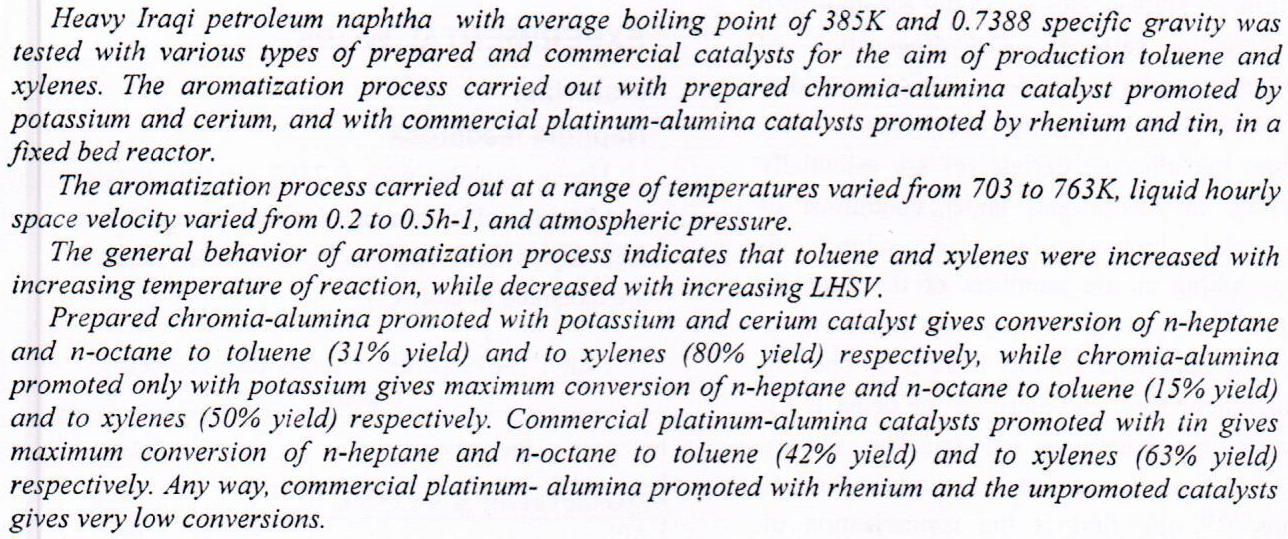
The study aimed to investigate the effect of different times as follows 0.5, 1.00, 2.00 and 3.00 hrs, type of solvent (acetone, methanol and ethanol) and temperature (~ 25 and 50)ºc on curcumin percentage yield from turmeric rhizomes. The results showed significant differences (p? 0.05) in all variables. The curcumin content which were determined spectrophotometrically ranged between (0.55-2.90) %. The maximum yield was obtained when temperature, time and solvent were 50ºC, 3 hrs and acetone, respectively.
The effects of using aqueous nanofluids containing covalently functionalized graphene nanoplatelets with triethanolamine (TEA-GNPs) as novel working fluids on the thermal performance of a flat-plate solar collector (FPSC) have been investigated. Water-based nanofluids with weight concentrations of 0.025%, 0.05%, 0.075%, and 0.1% of TEA-GNPs with specific surface areas of 300, 500, and 750 m2/g were prepared. An experimental setup was designed and built and a simulation program using MATLAB was developed. Experimental tests were performed using inlet fluid temperatures of 30, 40, and 50 °C; flow rates of 0.6, 1.0, and 1.4 kg/min; and heat flux intensities of 600, 800, and 1000 W/m2. The FPSC’s efficiency increased as the flow rate and hea
... Show More (43)
(43)
In this study, the energy charging mechanism is mathematically modeled to determine the impact of design modifications on the thermofluidic behavior of a phase change material (PCM) filled in a triplex tube containment geometry. The surface area of the middle tube, where the PCM is placed, is supported by single or multi-internal frustum tubes in vertical triplex tubes to increase the performance of the heating and cooling of the system. In addition to the ordinary straight triplex tubes, three more scenarios are considered: (1) changing the middle tube to the frustum tube, (2) changing the inner tube to the frustum tube, and (3) changing both the internal and central tubes to the frustum tubes. The impact of adopting the tube desig
... Show More (53)
(53)
 (48)
(48)
 (3)
(3)
 (1)
(1)
This study aims to evaluate the influence of the air abrasion of dentin on the shear bond strength of lithium disilicate using three different types of luting cements. Sixty cylindrical specimens were milled from lithium disilicate CAD/CAM blocks (IPSe.max CAD). Sixty sound human maxillary premolar teeth were decoronated to the level of peripheral dentin, then randomly divided into three groups according to the type of luting cement used for the cementation of the lithium disilicate specimens (n = 20); Group A: Glass ionomer cement (Riva Self- Cure); Group B: Adhesive resin cement (Rely X Ultimate); Group C: Self-adhesive resin cement (Rely X U200). Each group was then further subdivided into two subgroups (n=10); Subgroups AI, BI, and CI,
... Show MoreBackground: This in vitro study was carried out to investigate the effect of post space regions (coronal, middle and apical), the effect of post types ( Manually Milled Zirconia post, Prefabricated Fiber post, prefabricated Zirconia post) and the type of cement used (GIC, self-adhesive resin cement) on the bond strength between the posts and root dentin by using push-out test. Material and methods: Forty eight mandibular premolars extracted for orthodontic reasons (single rooted) were instrumented with ProTaper system (hand use) and obturated with gutta percha for ProTaper using AH26® root canal sealer following the manufacturer instructions. After 24 hours, post space was prepared using Zirix and Glassix drills no.3 creating 8 mm dept
... Show MoreBackground:sThe aims of this study were to evaluate and compare the ability of three different techniques to obdurate simulated lateral canals, evaluate the effect of the main canal curvature on obturation of lateral canals and compare the gutta-percha penetration between coronal and apical lateral canals. Materials and methods: Resin blocks with 30 straight and 30 curved were used in this study. Each canal has two parallel lateral canals. The main canal has 0.3 mm apical diameter and 0.04 taper. The canals were divided into six groups according to canal curvature and obturation techniques used (n=10): Groups C1 and C2: straight and curved canals obturated with continuous wave technique using E&Q masterTM system. Groups O1 and O2: straight
... Show MoreIn this paper, Pentacene based-organic field effect transistors (OFETs) by using different layers (monolayer, bilayer and trilayer) for three different gate insulators (ZrO2, PVA and CYEPL) were studied its current–voltage (I-V) characteristics by using the gradual-channel approximation model. The device exhibits a typical output curve of a field-effect transistor (FET). Source-drain voltage (Vds) was also investigated to study the effects of gate dielectric on electrical performance for OFET. The effect of capacitance semiconductor in performance OFETs was considered. The values of current and transconductance which calculated using MATLAB simulation. It exhibited a value of current increase with increasing source-drain voltage.
Objectives. This study was carried out to quantitatively evaluate and compare the sealing ability of Endoflas by using differentobturation techniques. Materials and Methods. After 42 extracted primary maxillary incisors and canines were decoronated, theircanals were instrumented with K files of size ranging from #15 to #50. In accordance with the obturation technique, the sampleswere divided into three experimental groups, namely, group I: endodontic pressure syringe, group II: modified disposable syringe,and group III: reamer technique, and two control groups. Dye extraction method was used for leakage evaluation. Data wereanalyzed using one-way ANOVA and Dunnett’s T3 post hoc tests. The level of significance was set at p<0:05. Results.
... Show More (3)
(3)
